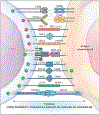Tolerance in the Age of Immunotherapy
- PMID: 32937048
- PMCID: PMC7534289
- DOI: 10.1056/NEJMra1911109
Tolerance in the Age of Immunotherapy
Conflict of interest statement
Disclosure forms provided by the authors are available with the full text of this article at
Figures




References
-
- Billingham RE, Brent L, Medawar PB. Actively acquired tolerance of foreign cells. Nature 1953; 172: 603–6. - PubMed
-
- Cooper MD, Peterson RD, Good RA. Delineation of the thymic and bursal lymphoid systems in the chicken. Nature 1965; 205: 143–6. - PubMed
-
- Miller JFAP. The golden anniversary of the thymus. Nat Rev Immunol 2011; 11: 489–95. - PubMed
Publication types
MeSH terms
Grants and funding
LinkOut - more resources
Full Text Sources
Medical
